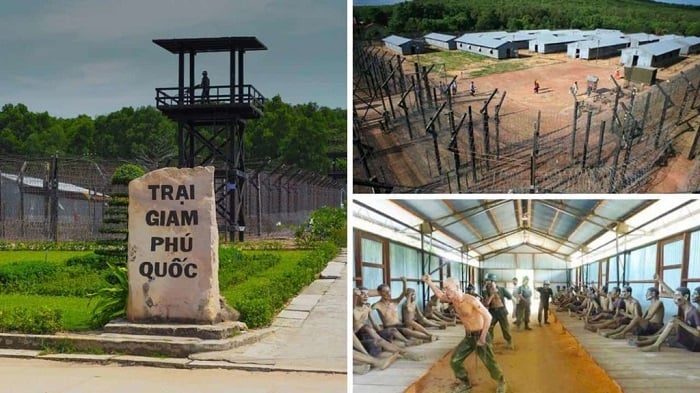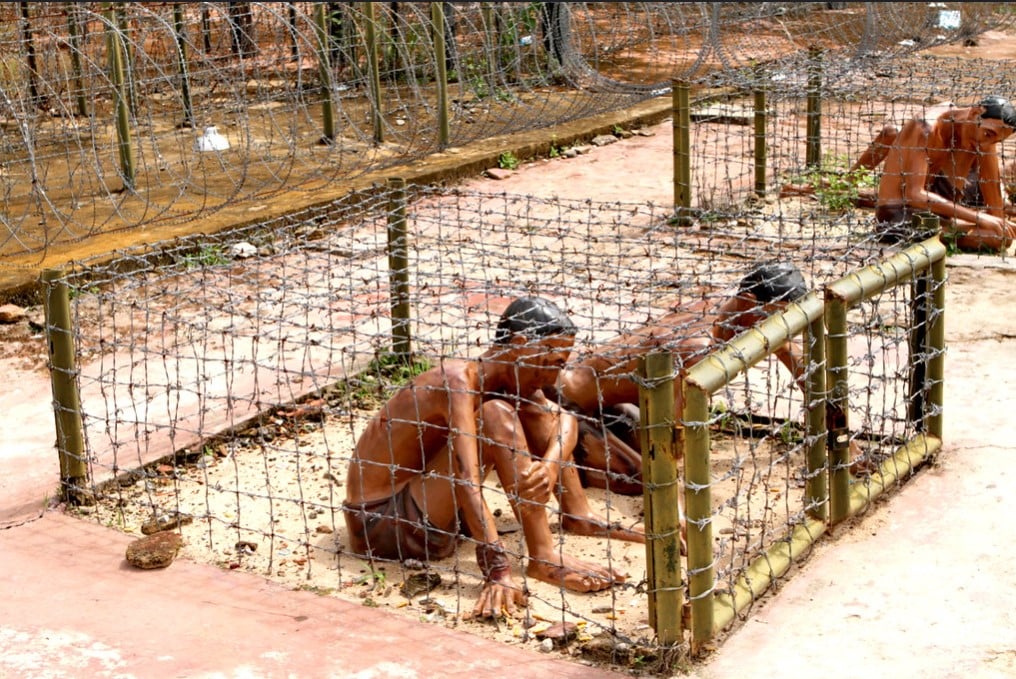Have you seen some Phu Quoc prison photos in your friend’s post and feel curious and want to explore this place? Phu Quoc prison is one of the most vivid historical testimonies of the resilient and persistent struggles of the Vietnamese people, as well as the atrocities committed by colonial imperialists. Although the war has passed, this place still remains a haunting memory for revolutionary soldiers and many visitors. Join Lily’s Travel to learn about Phu Quoc Prison through the article below!

Where is Phu Quoc prison?
The pearl island of Phu Quoc is not only famous for its pristine, charming beaches, luxurious resorts, or endless entertainment complexes. There is also a place here that was once known as “hell on earth” – Phu Quoc Prison – with a series of forms of corporal punishment and torture of prisoners that just once by visiting and listening to the explanation, it can enough to make you shudder.
Phu Quoc Prison is located at 350, Nguyen Van Cu Street, An Thoi Town, 28 km from the center of Duong Dong Town, Phu Quoc.

During the Indochina war, this prison was also called Cay Dua prison (Coconut prison Phu Quoc Viet Nam). This is the central prisoner of war camp in the entire Republic of Vietnam, once holding more than 32,000 prisoners of war. In 1995, this place was recognized by the Ministry of Culture and Information as a special national monument, and since then, the prison has been open to tourists.

Phu Quoc prison’s history
Phu Quoc prison has a long history and development. Originally a prison built by France called Cang Cay Dua (Căng Cây Dừa) , used to detain Vietnamese patriots. At that time, the area of the prison was 40 hectares and divided into 4 sections A, B, C, D. It was considered to be the largest prison in South East Asia then. But when the US increased its intervention in the war in Vietnam, the Saigon government constructed Cay Dua prison (Nhà lao Cây Dừa), also known as the Phu Quoc Prison.
The history of Phu Quoc Prison can be divided into 2 main periods:
Phu Quoc Prison during French colonialism in Vietnam

In 1949, after losing the battle to the Chinese People’s Liberation Army, the generals of the Chinese Nationalist army led more than 30,000 troops to flee to Vietnam, and stationed themselves in the south of Phu Quoc island.
In 1953, these people fled to Taiwan, leaving behind their homes and plantations. France took advantage of the existing barracks to establish Coconut Camp, also known as Cang Cay Dua (Căng Cây Dừa), to detain nearly 14,000 prisoners of war. After more than a year in the camp, 99 prisoners died, and 200 escaped. In July 1954, after the Geneva Accords, France returned most of the prisoners to the Vietnam government.
Coconut Tree Prison during the Vietnam War

In 1955, the government of the Republic of Vietnam built a new interment at the old Cang Cay Dua (Căng Cây Dừa), initially covering an area of 4 hectares, and named it Coconut Main Training Camp (Trại huấn chính Cây Dừa), also known as Cay Dua Prison.
In 1956, many prisoners from Gia Dinh Prison, Bien Hoa Main Training Camp, and various other prisons were transferred to Cay Dua Prison. Later, several political prisoners were also brought to Coconut Main Training Camp for detention.

The situation became unstable when about 100 prisoners escaped, with some being shot dead, leading to political prisoners being transferred back to the mainland or exiled to Con Dao Prison (Nhà tù Côn Đảo) in 1957.
Additionally, the government of the Republic of Vietnam constructed a larger detention camp spanning over 400 hectares in the An Thoi Town, about 2 km from the old Cang Cay Dua (Căng Cây Dừa). This camp was commonly referred to as the Phu Quoc Prison.
Since then, Phu Quoc Prison has become a detention center for prisoners of war in the Republic of Vietnam, with more than 32,000 prisoners of war, and is said to have applied brutal and barbaric corporal punishment.
The relics remaining today at Phu Quoc prison
Having gone through history and war, although no longer intact, the remaining relics of Phu Quoc prison are enough to make visitors understand the history of the war in Vietnam. The layout of the prison is both scary and fascinating. As you step through the gates, you’ll see the ruins of prison cells, torture chambers, and open prison yards, where countless stories of suffering are told. Conservation and restoration efforts have maintained these structures, allowing visitors to witness the harsh reality of life inside Phu Quoc prison.
Gate of the 8th Military Police Battalion at Phu Quoc Prison
The gate of the 8th Military Police Battalion is made of iron pillars and solid bricks, forming 2 square pillars on both sides. The restored relic is exactly like the original.
Prisoner graveyard

The prisoner graveyard at Phu Quoc Coconut Tree Prison is about 20,000 square meters and about 1 km away from the prison – B2 section. This graveyard was designed in a circular shape, above is a fist-shaped monument representing the indomitable, heroic and resilient spirit of its Vietnamese predecessor.
Kien Van (Kiến Văn) Church at the prison in Phu Quoc
After the war, Kien Van Church now is a ruin with only cement columns remaining, covering an area of more than 4,000 square meters.
Exhibition house of relics

The exhibition house is divided into 2 rooms. Including, one room contains some artifacts along with the history and development of Phu Quoc Prison. The other one holds 100 documentary photos of the enemy’s torture methods as well as the ways the Vietnamese revolutionary soldiers were tortured.
B2 section in Phu Quoc Prison

B2 section is currently being restored with an area of more than 17,000 square meters, including items such as: watchtower (vọng gác), fence, prison gate of B2 section, barbed wire tiger cage, kitchen, dining room , detention and torture areas for prisoners of war…There were 40 types of different brutal tortures used to punish Vietnamese revolutionary soldiers.

Monument to martyrs at Doi Sim (Đồi Sim)

Nestled on 12,420-square-meter land, Doi Sim martyrs cemetery is a metaphor for the martyrs and Phu Quoc Coconut Tree Prison. The monument was designed with 5m high waves on both sides and a pointed block hollowed out in the middle about 2m, meaning “To people who lost their lives here”
Gate of the 7th Military Police Battalion
Battalion 7’s gate is about 4.1m high and 0.85m wide, the two gate pillars are 5.9m apart. Close to the gate pillar, from the left side, is a summary board of the 7th Military Police Battalion.
Gate and house of the Prison Command Board in Phu Quoc Prison

Currently, the gate and the prison command board’s house have been restored with reinforced concrete, corrugated iron roofs, and wooden windows. The main gate door is made of strategic iron bars and barbed wire.
Historical significance of Phu Quoc prison
If the places to visit and have fun in Phu Quoc show us the prosperity and appeal of this island, Phu Quoc prison shows a painful silence. This place has kept the heinous crimes of American imperialism and French colonialism in Vietnam. They do not hesitate to use barbaric methods to torture and destroy Vietnamese soldiers’ will to fight.

Each corner of the prison, each story of a soldier demonstrates the resilient, indomitable and heroic fighting spirit of our nation. Visiting Phu Quoc prison, we can see the severity of war as well as better understand the nation’s history.
The prison symbolizes the relentless spirit and courage of the Vietnamese people in their struggle against foreign domination. Many of those imprisoned were revolutionaries who continued to fight for independence even from within the prison walls.
Today, Phu Quoc Prison serves as a historical monument, educating visitors about the country’s past struggles. It stands as a memorial to those who suffered and a reminder of the atrocities committed, playing a crucial role in Vietnam’s collective memory.
Experiences not to be missed at Phu Quoc prison relics
Visiting Phu Quoc Prison is an indispensable experience for anyone interested in Vietnamese history and the resilience of its people. To make the most of your visit, there are some key experiences you shouldn’t miss. These activities and exhibitions not only enhance your understanding but also provide a profound and moving encounter with history. Below are experiences that will make your visit to Phu Quoc Prison memorable and impressive.
Coming to Phu Quoc Prison, area B2 is the most notable area of Phu Quoc Prison. This is where the most realistic scenes of brutal prison torture are recreated, such as tiger cages with barbed wire, 3-inch or 7-inch nails nailed to body parts, and chiseling and breaking teeth with hammers. Tourists visiting this place will feel the pain. Moreover, they will also see the strong will and determination to fight off the resilient soldiers at that time. Only by witnessing with their own eyes and listening to tour guides tell cruel stories can visitors clearly feel the brutal reality of the struggle for independence of the Vietnamese army and people in the past.


The historical exhibits at Phu Quoc Prison are a must-see.These exhibits often include multimedia presentations, audio narrations, and tactile elements that allow you to connect more deeply with the history. Stroll through the outdoor exhibitions that display larger artifacts and provide a sense of the prison’s scale. These areas often include original structures and recreated scenes from the prison’s operation. Exploring these exhibitions gives you a better understanding of the physical layout and the environment in which the prisoners lived.

Take a moment to visit the memorial areas dedicated to the prisoners who suffered and died at Phu Quoc Prison. These spaces are designed for reflection and remembrance, allowing you to pay your respects. The solemn atmosphere of the memorial areas underscores the gravity of the site’s history and the sacrifices made by the prisoners.
Important things to know when visiting Phu Quoc prison

When visiting Phu Quoc Prison, there are several important things to keep in mind to ensure a respectful and informative experience:
- When visiting Phu Quoc Prison, it is crucial to dress modestly and maintain a quiet demeanor to show respect for the historical site. Refrain from touching or damaging any artifacts or display objects in the museum.
- For outdoor visits to Coconut Prison, it is advisable to apply sunscreen and bring sunglasses and a jacket. As the heavy rainy season in Phu Quoc lasts from August to October, carrying an umbrella is recommended when exploring outdoor exhibitions.
- Phu Quoc Prison caters to international visitors with English descriptions and narrations. Due to the graphic depictions of violence and torture, as well as grim images of prisoners, the site is not suitable for children.
- Visitors should bring their own food and water since the prison covers a large area, making it difficult to find refreshments while sightseeing. Additionally, ensure to dispose of trash properly to maintain the site’s cleanliness.
- Note the places that allow or do not allow photography in Phu Quoc prison.
- The prison operates from 8:00 a.m. to 11:30 a.m. and from 1:30 p.m. to 5:00 p.m. Admission is free of charge.
Lily’s Travel – Explore and appreciate history with you

Since 2007, for over 15 years, Lily’s Travel has been a leading tour operator in Vietnam. We are a team of passionate travel specialists dedicated to showcasing the captivating beauty and rich cultural tapestry of Vietnam, Laos, and Cambodia.
Do you want to discover a heroic history of the Vietnamese people? Come with Lily’s Travel to Phu Quoc Prison – a destination not to be missed when traveling to the pearl island of Phu Quoc!
Why should you visit Phu Quoc Prison with Lily’s Travel?
Visiting Phu Quoc Prison with Lily’s Travel offers a deeply meaningful journey where you can witness historical relics firsthand and hear heart-touching stories of resilient prisoners, allowing you to gain a profound understanding of the nation’s painful yet proud history. Our professional tour guides, who are both knowledgeable and enthusiastic, provide authentic and vivid accounts of life in the prison, making the experience truly immersive. This tour is more than just a travel itinerary; it is a living history lesson that helps you appreciate the value of freedom and peace on a much deeper level.
Discover the rich history and cultural heritage of Phu Quoc Prison with Lily’s Travel.Join us to explore the past, honor the memories, and gain a deeper understanding of Vietnam’s history. Don’t miss the opportunity to explore one of Vietnam’s most important historical sites!
Please contact Lily’s Travel today to book and receive attractive offers.
Tel/WhatsApp/Viber: +84931152368
Line/WhatsApp: +84949094727 (中文服务热线)
Email: (Normally reply in 2 hours): [email protected]
Website: https://lilystravelagency.com/
Address in Vietnam: 20 Ngo Huyen, Hoan Kiem District, Hanoi city, Vietnam; 16A Ly Nam De st, Hoan Kiem District, Hanoi city, Vietnam
Address in Taiwan: Xinbei City, Xinchuang District , Minanxi Street, 75 lane 1st floor
Lily’s Travel – Explore the past, create the future!
Readmore: Phu Quoc 4 islands day tour















